Noseda leads National Symphony in a fresh and blazing Beethoven Fifth

Gianandrea Noseda conducted the National Symphony Orchestra Thursday night at the Kennedy Center. File photo: Scott Suchman
When was the last time you were truly blown away by a performance of Beethoven’s Fifth Symphony?
Gianandrea Noseda and the National Symphony Orchestra unleashed an urgent, explosive yet meticulously detailed performance at the Kennedy Center on Thursday night that did just that. The Beethoven closed a program that, began with music of Schoenberg and Brahms.
With a little bit of stage drama, Noseda came on stage after intermission, took a perfunctory bow, whipped around, punching the down-beat as he turned, and they were off. What followed was serious, exhilarating and sometimes surprising. There was a searching delicacy in the playfulness of the third movement that, at times, sounded almost intimate, the strings so soft that their sound was more aura than substance. The brass in the final movement exuded elation more than triumph, and, throughout, the performance radiated joy, as if Noseda was exploring Beethoven’s soul, not just his mind. The orchestra was on the top of its game and swept up in Noseda’s energy and intensity, playing the symphony as if it were a fresh experience.
Schoenberg began work on his Chamber Symphony no. 2 (for 15 players) in 1906 while he was still writing largely tonal music. Struggling to finish, he put it away for almost 30 years, an interval he spent developing the twelve-tone harmonic system for which he became famous (or, in some circles, infamous). But when, on the urging of a colleague he picked it up again in 1933, he chose to return to a tonal idiom. Although “Chamber” has stuck to its title, at some point along the way, the piece grew to full symphonic proportions.
There’s a sweetness to the symphony’s two movements that Noseda and the orchestra projected beautifully. The first movement, somewhat dark and anxious, builds in waves of tension, never hurried but inexorable. The melodic fragment first heard in the flute wanders around the orchestra, and different timbres give it very different personalities but all quite gentle and transparent. The second movement is sunnier and more scattered with shards of themes tried out in various combinations, its many solos strewn around the orchestra reflecting its chamber origins.
Between the Schoenberg and the Beethoven, not so much a bridge as a cushion, was a lush and colorful reading of Brahms Variations on a Theme by Haydn. Noseda focused on contrasts of mood here, the mistiness of the first variation, the careful balance of interweaving melodies in the fourth and the blaze of sunlight as the music shifts from minor to major in the majestic final passacaglia.
The program will be repeated 8 p.m. Friday and Saturday. Kennedy-center.org


